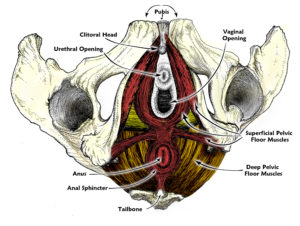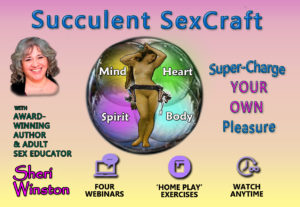Solo Sex!
Solo Sex – it’s sex with someone you love! Find out why I don’t call it masturbation and why it’s so good and important to do.
Solo Sex – it’s sex with someone you love! Find out why I don’t call it masturbation and why it’s so good and important to do.
The Crescent Pillow can make sex better by providing more position options and easing some body limitations!
 A Glimpse Into Vaginal Ecology
A Glimpse Into Vaginal Ecology
The vagina isn’t just a nice place to own or visit, nor is it merely a passive space awaiting fulfillment; it’s a complex, integrated environment. Your vagina is a dynamic system with inherent safeguards in place to maintain a healthy equilibrium despite being susceptible to myriad influences that can alter its state of balance.
Basically, by understanding the system, you can learn to keep yourself healthy, and prevent most vaginal infections and problems. Your vagina is a self-regulating, self-cleaning, resilient yet delicate ecosystem and the less you disrupt the natural balance, the better off you’ll be. This is what every woman needs to know!
Check out my award-winning book, Women’s Anatomy of Arousal.
 You can also explore the online course by the same name, Women’s Anatomy of Arousal Online Course to learn about all things vagina!
You can also explore the online course by the same name, Women’s Anatomy of Arousal Online Course to learn about all things vagina!
Here’s a simple breath technique for relaxing, getting centered and present. Good for sex and for the rest of your life, too!
(JUST CLICK ON THE IMAGE ABOVE TO WATCH THE VIDEO.)
Discover the best natural sexual lubricant — and it tastes good, too!
With all this public talk about ‘open marriage’ it might be helpful to define what it is not. It is not having an adulterous affair. It does not involve lying, cheating or stealing (as in stealing your partner’s choice about who does what with whom). It is not that one person wants more sexual partners and the other does not. It is certainly not when one person is already having an adulterous affair. That’s not open, that’s cheating!
Open marriage is a consensual agreement about relationship boundaries. It includes non-monogamy in many forms, polyamory and swinging being two common ones. In general, polyamory focuses on relationships that include intimacy and erotic connection with more than one partner. Swinging tends to focus on the sex, with a more recreational, non-ongoing connection, although the intimacy may creep in with repeated liaisons. In any case, the hallmarks are that everyone involved is open and honest and in agreement about what’s happening.
I wince when I hear uninformed people talking about how “open relationships don’t work”. They often add that “I tried it once (or a friend did) and it was unsuccessful” or, more likely, that it was a relationship disaster. I often respond by acknowledging that while that may be true, and that clearly monogamy “doesn’t work” either. Otherwise why would we have such high rates of divorce, dissatisfaction and adultery?
Relationships, whether monogamous, polyamorous or open in any sense all require good relationship skills to thrive. Maturity, the ability to work things out and, above all communication skills are needed for sustainable intimate connections to prosper. In general, I would say that open relationships do require a higher level of skill. But let’s face it in order for any relationships to sustain over time, to be joyful, loving and remain connected takes work (and play too, but that’s another topic).
It is so past time to start to shift our cultural attitudes about relationship forms. The time is now to support integrity, honesty and tolerance for consensual agreements of all sorts. I would love to see a world where we valued honesty and integrity as the standard for all relationships whatever form they take.
It’s all over the news—there’s an epidemic infecting long-term intimate connections. Partners still love each other, but they’ve lost that erotic charge.
Sexless marriages are apparently commonplace. I hear the moans (not the good kind!) all the time in my classes and practice. “The honeymoon is over.” “I used to be so hot for her.” “We never have sex anymore!”
hot for her.” “We never have sex anymore!”
Where does it go? Why is it that the most burning passionate relationships fade to a warm glow? Does monogamy inevitably lead to monotony and from there to sexual indifference? The fact is that the biochemicals of in-loveness, that simmering pheromonal soup of sexiness, does indeed diminish over time. Across cultures, the average time that a couple stays together is only four years, just when that complex and heady perfume of lust and its chemical underpinnings fades away.
It’s just reality—familiarity leads to feeling like, well, family—and we’re biologically programmed to not want to have hot steamy sex (or any sex at all, for that matter) with our family members.
While it’s definitely natural for desire to wane, we do have the power to keep the flame burning if we know how to stoke the fire. So what’s a couple to do if they want to stay together and sustain a state of loving lusty heat with each other?
Personally, I believe that great sex is the glue and the lubricant of long-term relationships. So, to battle the forces of boredom and combat the spreading tide of lustlessness, here are five tips to sending that sizzle arcing between you again:
1. Hot, wet, kisses! No kidding. Cut out that dry peck of a kiss as you go off to work. Forget about that quick cool little lip press that you could just as easily give your mother. Really deeply kiss each other. It doesn’t have to take long, but a minute (yes, a whole minute) of soft, wet, slippery lips and tongues is an instant antidote to feeling like family. When we taste each other, we’re sharing and stirring the chemical stew of seduction and putting the burner on simmer for later feasting. I recommend a minimum daily dose of 5—10 seriously steamy kisses per day.
2. Eyes to eyes. Think of new lovers and how they devour each other with their eyes. Long, soulful looks pass between them, as they shine that love-light into each other’s eyes, which connect directly to their hearts. Prescription: act like lovers, look at each other the way lovers do and you’ll fire up that ‘you’re so yummy, I can’t take my eyes off of you’ energy.
3. Go to bed early. Turn off  the TV, the computer and the phones and go get in bed! Make an intimacy date to snuggle and talk, to pet and play. It’s okay if you’re tired. Make the date about connecting, without the pressure or expectation of sex. Just make time to touch and be in physical contact, to unwind and share. Sometimes it will lead to sex, sometimes not. That’s alright. Just make the time to be in your bodies together, and good stuff will come out of it. Turn the outside world off, and you’ll create space to turn on to each other. Recommended dose: at least once a week, and more is definitely better!
the TV, the computer and the phones and go get in bed! Make an intimacy date to snuggle and talk, to pet and play. It’s okay if you’re tired. Make the date about connecting, without the pressure or expectation of sex. Just make time to touch and be in physical contact, to unwind and share. Sometimes it will lead to sex, sometimes not. That’s alright. Just make the time to be in your bodies together, and good stuff will come out of it. Turn the outside world off, and you’ll create space to turn on to each other. Recommended dose: at least once a week, and more is definitely better!
4. Have play dates. Laughing leads to sex. Smiles warm the cockles of the heart (and elsewhere). I don’t know where I got the idea when I was younger that sex is serious business, but it’s also about fun, play and creativity. Toys and props are good, but nothing beats the power of your own imagination and inventiveness. (What if I slather this there and rub that on this?) Make up games. (I’ll show you mine if you show me yours!) Play pretend (pirates anyone?). Remember, it’s sex play, not sex work! Joy really is the best medicine in the bedroom, so giggle, tickle, wrestle and romp and you’ll be sure to have your minimum daily requirement of sexy fun.
 5. Breathe together. Breath is one of our most basic tools for connecting with ourselves and others. When we breathe together, we entrain all the rhythms of our bodies. When we play with exchanging breath, we fire up our erotic energy. There’s no one right way to us to breathe, so feel free to make this a game to explore and experiment with. Slow down and let your breathing relax you and help you tune in to yourself and your partner. Or speed up and allow your breathing to pull you into deeper arousal. Encourage each other not to hold your breath, but to keep it moving as you ride the arousal and orgasmic waves. My best medical advice: practice conscious expanded active breathing often. Do it alone. Do it together. Do it with love. Do it often to get a healthy erotic flame flowing freely between you.
5. Breathe together. Breath is one of our most basic tools for connecting with ourselves and others. When we breathe together, we entrain all the rhythms of our bodies. When we play with exchanging breath, we fire up our erotic energy. There’s no one right way to us to breathe, so feel free to make this a game to explore and experiment with. Slow down and let your breathing relax you and help you tune in to yourself and your partner. Or speed up and allow your breathing to pull you into deeper arousal. Encourage each other not to hold your breath, but to keep it moving as you ride the arousal and orgasmic waves. My best medical advice: practice conscious expanded active breathing often. Do it alone. Do it together. Do it with love. Do it often to get a healthy erotic flame flowing freely between you.
If the embers of your relationship are going out, now is the time to stir the coals, add some fuel and get the blaze burning again. Let’s end that insidious epidemic of sexless relationships and show those newlyweds that old fires can blaze even hotter than new ones!
There’s a big difference between touching and feeling. When you touch something, you experience it more abstractly and less intimately than if you’re feeling it. Touch is mediated by all sorts of expectations and assumptions. For instance, if you’re touching skin, the experience is mediated by your awareness of what skin is supposed to feel like, and also by how you’re supposed to touch it in order to touch it “well.” There’s nothing wrong with this sort of touch, but it lacks a certain specialness. It lacks what Zen practitioners call beginner’s mind.
Feeling something is very different. It’s like the first time, every time.
You can discover the difference by playing the following game with yourself. First, choose a part of your body and touch it. Don’t make a big deal out of it. Caress it, squeeze it … make contact with it in the ways you normally would.
Now pretend that you’re a Martian and this is your first encounter with an Earthling. You’ve never encountered skin before; your language doesn’t even have a word for it! Now touch this same part yourself. Explore it with the curiosity and innocence you’re bring to a totally (and literally) alien experience.
When you’ve finished, take a few moments to register the difference between touching, which is what you did on the first round, and feeling, which is what your Martian alter ego did. If you wish, jot down some notes.
There is nothing wrong with touching. We do it all the time, and it’s fine. Feeling, however, has a magical sensuous quality that standard-issue touching lacks. When you’re practicing touch (and I’m using it in the generic sense here), make a point of folding feeling into your repertoire.
Men, do you want to NOT make the same mistakes so many other guys do (and so many women complain about)?
Women, do you want a quick-and-easy way to clue your guy into what works and what doesn’t for you?
Then read what follows!
 Your inner pelvic muscles are one of the keys to turning yourself on. When you squeeze and release them, you’re actually sexually playing with yourself without using your hands (or anyone else’s). The pelvic floor muscle layers form a sandwich with your erectile network in the middle, so that moving these muscles directly stimulates your engorgeable tissue.
Your inner pelvic muscles are one of the keys to turning yourself on. When you squeeze and release them, you’re actually sexually playing with yourself without using your hands (or anyone else’s). The pelvic floor muscle layers form a sandwich with your erectile network in the middle, so that moving these muscles directly stimulates your engorgeable tissue.
During orgasm, these muscles rapidly and rhythmically contract and release, sending waves of pleasure through the pelvis — and, if you’re naturally lucky or have learned how, through the entire body.
You have both voluntary and involuntary control of these muscles. That is, you can let the muscles do their thing entirely on their own or, if you want to expand the experience, you can pump, pulsate or play with them as a unit or as separate sub-groups.
 Whether you’re a man or a woman, you can use the pelvic floor muscles to initiate your turn-on or add fuel to your sexual fire. Working them stimulates the nerves and increases the blood flow to your pelvis, which increases your engorgement and erection (or herection). The pelvic floor also acts like an energy trampoline, bouncing the sexual energy up into the rest of your body.
Whether you’re a man or a woman, you can use the pelvic floor muscles to initiate your turn-on or add fuel to your sexual fire. Working them stimulates the nerves and increases the blood flow to your pelvis, which increases your engorgement and erection (or herection). The pelvic floor also acts like an energy trampoline, bouncing the sexual energy up into the rest of your body.
Keeping these muscles toned is important for general pelvic health throughout a woman’s lifetime. They’re also the muscles used to birth a baby. Strong, flexible and skilled muscles can facilitate efficient labor (a good thing), support the natural processes (a very good thing), and even promote ecstatic birth (a great thing!). After childbirth, it is especially important to re-strengthen and tone these muscles. The pelvic floor muscles hold up the pelvic organs and keep gravity from having its way with a woman as she ages. For women with bladder control problems, a low or “dropped” uterus or “female” problems, or for anyone with constipation, strengthening these muscles can help enormously. And for women who wish to improve their sexual responsiveness, learning to work with these muscles is an all-important first step.
In fact, I’ll take this further: getting in touch with your pelvic floor muscles is the foundation to becoming an erotic virtuoso.
 Are you ready to have Sheri personally help you learn to play your own instrument with skill and passion?
Are you ready to have Sheri personally help you learn to play your own instrument with skill and passion?